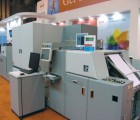
In these Frank showed surprise at the structure of the printing industry in many of these areas and saw them as potentially major competition for printers in the western world.
Over the years I too have been to many countries in South East Asia that Frank visited and have seen how the printing industry has developed. Apart from Japan where there have always been printers of the very highest quality, I found quality state of the art printing establishments using the very latest equipment, and producing work of superb quality, among them C&C Offset Printing in Hong Kong and Cyberprint in Thailand.
I recently had the honour of speaking at the ADDA Conference in Singapore and attending the sixth annual Asian Print Awards presentations organised and run by well-known south east Asian regional publisher, Paul Callahan, and sponsored by many of the leading industry suppliers.
In many parts of the world print awards are very popular to identify the best printers in a particular country. They are also a good opportunity for printers to get together over an enjoyable dinner and the occasional tipple of alcohol. What is unique with the Asian Print Awards compared with other country print awards? Entries come from all over south east Asia and this year there were over 400 of them, the largest number coming from Japan. There was a 60 per cent increase over 2007 in entries in the digital sector.
I had the opportunity to spend some time looking at all the nominated entries selected by the judges for the short list for winning either Gold, Silver or Bronze awards prior to the awards dinner. I was highly impressed with the quality of the print and the innovative approaches being shown. This was using both offset and digital printing.
What was most interesting however was an analysis of the type of work that won the key awards and where it was printed. Quality Asian printing is no longer limited to a few major printers in Hong Kong and Thailand as well as printers in Japan. The entries from all over south east Asia were of an exceptional quality. This is not surprising, as this area of the world has been investing heavily in the latest offset and digital presses from the United States, Europe and Japan. Their printers are highly skilled and they probably have a better training today than do printers in the West.
When I analysed the winners of the awards, it appeared that the centre of excellence of south east Asian printing has shifted to Thailand. Cyberprint is no longer the only leading-edge printer. There are now printers in Thailand excelling in all areas of print, perhaps with the exception of digital printing. Overall, printers from Thailand picked up 10 Gold awards, four Silver and six Bronzes.
In contrast, Japanese printers who submitted the largest number of entries, only won one Gold, four Silver and five Bronzes. Hong Kong was perhaps the second most successful country with five Gold, five Silver and four Bronze awards. It was interesting to see the rise of other countries: Indonesia and India both won four Gold awards, Singapore three, Malaysia two and China two.
What this shows is that while many printers in the West think that work is moving to south east Asia because of cost, it is not doing so at the expense of quality. The quality being achieved in Asia is as good as anything in the West.
The credit crunch may prove a problem where for example demand for printed products to support the export market has dropped substantially in China. We could see the very large Chinese print industry redirect its focus to capturing printing work from the West. This potentially causes a major problem for Western printers.
With the ability of the Internet allowing online ordering and working, it is now very easy for Western print buyers to deal with advanced south east Asian printers. In that situation, the costs of printing in south east Asia are far lower than in the West and delivery may be the only real differentiator.
We are already seeing most of the coffee table colour books being printed in this area of the world. We may now also expect packaging to move, and even some magazine and promotional printing.
The challenge for Western printers is how to add value to the work they do to counter the advantages of south east Asian printers. With demand for print dropping, the last thing Western printers need is increased competition from south east Asia. We can expect such competition to increase.
Comment below to have your say on this story.
If you have a news story or tip-off, get in touch at editorial@sprinter.com.au.
Sign up to the Sprinter newsletter
